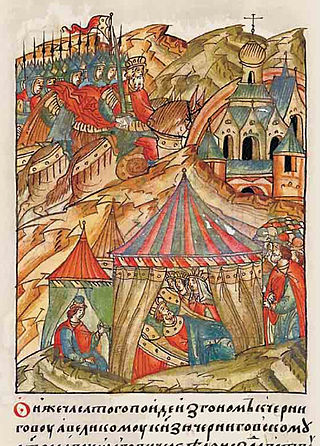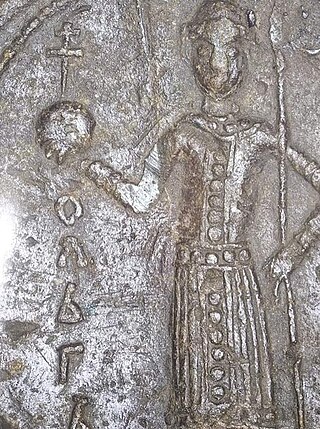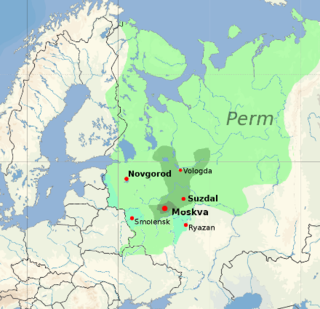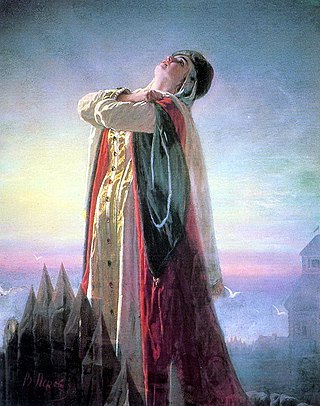
Ivan III Vasilyevich, also known as Ivan the Great, was Grand Prince of Moscow and all Russia from 1462 until his death in 1505. Ivan served as the co-ruler and regent for his blind father Vasily II before he officially ascended the throne.

Sviatoslav Olgovich was Prince of Novgorod (1136–1138); Novgorod-Seversky (1139); Belgorod-Kievsky (1141–1154); and Chernigov (1154–1164). He was the son of Oleg Sviatoslavich, the prince of Chernigov, and an unnamed daughter of Aepa, a Cuman khan.
Iziaslav IV Vladimirovich was Prince of Terebovl' (1210), Novgorod-Seversk and Grand Prince of Kiev (1235–1236). He was the son of Vladimir Igorevich.

Oleg Svyatoslavich was a prince from Kievan Rus' whose equivocal adventures ignited political unrest in the country at the turn of the 11th and 12th centuries. He reigned as Prince of Chernigov from 1094 to 1097, and as Prince of Novgorod-Seversk from 1097 to 1115. He was the progenitor of the Olgovichi family.
Severia or Siveria is a historical region in present-day southwest Russia, northern Ukraine, and eastern Belarus. The largest part lies in modern Russia, while the central part of the region is the city of Chernihiv in Ukraine.

Igor Svyatoslavich, nicknamed the Brave, was Prince of Novgorod-Seversk (1180–1198) and Prince of Chernigov (1198–1201/1202).
Vasily Danilovich Kholmsky was a Russian knyaz, Boyar and Muscovite voyevoda. He was the son of Prince Daniil Kholmsky and the son-in-law of Grand Prince Ivan III, having married his daughter Feodosiya Ivanovna. Kholmsky was a member of the princely house Kholmsky, and descended from the rulers of the Principality of Tver.
The Muscovite–Lithuanian Wars were a series of wars between the Grand Duchy of Lithuania, allied with the Kingdom of Poland, and the Grand Duchy of Moscow, which was later unified with other Russian principalities to eventually become the Tsardom of Russia. After several defeats at the hands of Ivan III and Vasily III, the Lithuanians were increasingly reliant on Polish aid, which eventually became an important factor in the creation of the Polish–Lithuanian Commonwealth. Before the first series of wars in the 15th century, the Grand Duchy of Lithuania controlled vast stretches of Eastern European land, from Kiev to Mozhaysk, following the collapse of Kievan Rus' after the Mongol invasions. Over the course of the wars, particularly in the 16th century, the Muscovites expanded their domain westwards, taking control of many principalities.

The Principality of Ryazan, later known as the Grand Principality of Ryazan, was a principality from 1129 to 1521. Its capital was the city of Ryazan, now known as Old Ryazan, which was destroyed in 1237 during the Mongol invasions. The capital was moved to Pereyaslavl-Ryazansky, later renamed Ryazan.

The Principality of Novgorod-Seversk or Novhorod-Siversk was a medieval Rus' principality centered on the town now called Novhorod-Siverskyi. The principality emerged after the central power of Kievan Rus' declined in the late 11th century, and Sviatoslav Olgovich managed to establish a local dynasty, the Olgovichi, as a branch of the Rurikid house. Novgorod-Seversk was originally a subdivision of the Principality of Chernigov, and would go on to include territories that were earlier part of Chernigov and the Principality of Pereyaslavl.
The Prince of Chernigov was the kniaz, the ruler or sub-ruler, of the Rus' Principality of Chernigov, a lordship which lasted four centuries straddling what are now parts of Ukraine, Belarus and the Russian Federation.
The Prince of Smolensk was the kniaz, the ruler or sub-ruler, of the Rus' Principality of Smolensk, a lordship based on the city of Smolensk. It passed between different groups of descendants of Grand Prince Iaroslav I of Kiev until 1125, when following the death of Vladimir Monomakh the latter's grandson Rostislav Mstislavich was installed in the principality, while the latter's father Mstislav I Vladimirovich became Grand Prince. It gained its own bishopric in 1136. It was Rostislav's descendants, the Rostaslavichi, who ruled the principality until the fifteenth-century. Smolensk enjoyed stronger western ties than most Rus' principalities.
The Prince of Murom was the title of the ruler of the Principality of Murom.

The Principality of Murom, also referred to as the Murom-Ryazan Principality until the mid-12th century, was a principality with its capital in Murom, now in Vladimir Oblast, Russia. Murom lay in an area that was strongly Finnic and for much of its medieval history, located in the homeland of the Muromians. In 1392, it was incorporated into the Grand Principality of Moscow.

The Council of Liubech was one of the best documented princely meetings in Kievan Rus' that took place in Liubech on October 19, 1097. The council ended the Chernihiv war of succession (1093–1097) between Sviatopolk II of Kiev, Vladimir II Monomakh and Oleg I of Chernigov who fought for the heritage of his father Sviatoslav II of Kiev.

The Principality of Moscow or Grand Duchy of Moscow, also known simply as Muscovy, was a principality of the Late Middle Ages centered on Moscow. It eventually evolved into the Tsardom of Russia in the early modern period. The princes of Moscow were descendants of the first prince Daniel, referred to in modern historiography as the Daniilovichi, a branch of the Rurikids.
Mstislav II Svyatoslavich was a Kievan Rus' prince. His baptismal name was Panteleymon. He was probably prince of Kozelsk (1194–1223), of Novgorod-Seversk (1206–1219), and of Chernigov (1215/1220–1223). He was killed in the Battle of the Kalka River.
Oleg III Svyatoslavich was a Kievan Rus' prince. His baptismal name was Feodosy. He was prince of Vshchizh, of Novgorod-Seversk (1200–1201), and of Chernigov (1201/1202–1204).
Davyd Sviatoslavich was the ruler of Murom and Chernigov.

Euphrosyne Yaroslavna was the wife of Igor Svyatoslavich, Prince of Novgorod-Seversk and daughter of the Galician prince Yaroslav Osmomysl. She is one of the central characters in The Lay of Igor's Campaign. 'Yaroslavna's Lament' is considered one of the most poetic fragments of the Lay.









